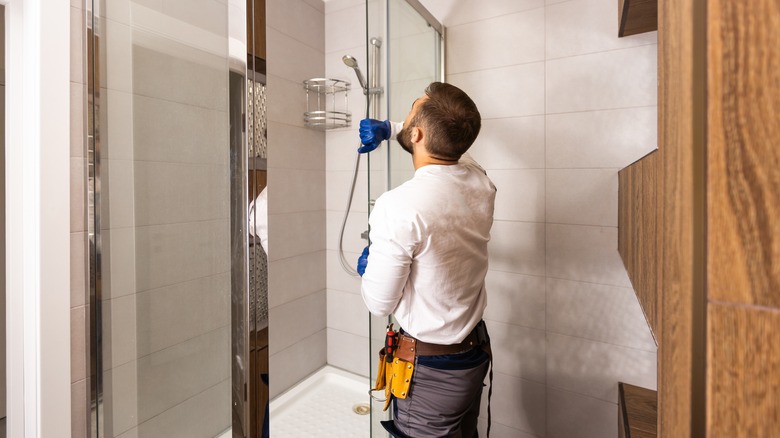Our Real Estate Expert Names The Bathroom Renovation That Could Diminish Your Home's Resale Value
Regardless of whether you plan to sell your home or live out your days inside of it, we are always looking for ways we can increase our home's value. Aside from kitchens, bathrooms are one of our most utilized areas, and it only makes sense that we want to invest in these spaces. However, one can make mistakes when renovating their bathroom, such as adding wood into the mix. In an exclusive interview with House Digest, Ron Wysocarski, Broker and CEO at Wyse Home Team Realty, advises homeowners to avoid incorporating wood into their bathrooms. "Upgrading to wood, such as wooden tiles, vanity, and panels, reduces home value no matter the rustic cabin vibe it gives," he said.
Wood is a porous material, and the combination of the two can be disastrous in an area like our bathrooms that experience high levels of moisture and humidity. Wysocarski explains, "Even though bathroom renovations significantly increase the home value, it's better to play it safe with neutral remodeling. For instance, a jacuzzi or ornamented tiles seem posh in concept, but prospective buyers might value functionality and upkeep over luxury." And, unfortunately, wood in our bathrooms will need a lot of time and commitment if you hope to keep it in good condition. Wood offers our spaces many styles, whether sophisticated and sleek or rustic and shabby chic. If removing wood from your design arsenal isn't an option, Wysocarski has some helpful tips to make the endeavor easier and more manageable.
Avoiding wood in bathrooms
In an exclusive interview with House Digest, real estate expert Ron Wysocarski explains that including wood in our bathrooms harms a home's resale value. However, even if you aren't looking to sell, you should still think twice before making the commitment. "Wooden bathrooms can be a homeowner's nightmare due to their musty smell, mold fungus, and rot," he said. "Since wood in bathrooms needs a meticulous upkeep regiment –- constant airflow, moping, and drying –- prospective buyers count them as a feature that needs to be replaced. Hence, wooden bathroom renovation reduces the home value."
As lovely as wood looks in our design aesthetics, it is a very porous and hygroscopic material. It will be susceptible to absorbing and releasing moisture as your bathroom's humidity levels fluctuate. Different types of wood will vary in how porous they are and how they respond to moisture. Still, you can generally always expect adverse side effects like warping as the wood expands and contracts, discoloration, cracking and splintering, and overall deterioration with time. It's possible to try to limit the water exposure wood sees in our bathrooms, but unfortunately, we can't eliminate it altogether, with our sinks, showers, and toilets being essential for the room to function as it should. For most, it will simply be best to avoid the issue altogether and choose more suitable materials for our space, like quartz, porcelain, copper, and ceramic tile.
Still want to use wood? Here's how
Suppose you are committed to including wood in your bathroom and cannot envision another material replacing it. Some ways to navigate wood's challenges in humid environments do exist. "If you still want to incorporate wood in the bathrooms, use it in the bathroom that brings in abundant air and light or a separate exhaust fan to keep the zone clean and dry," Ron Wysocarski said in an exclusive interview with House Digest. "Adding them to the vanity as cabinets and beside the mirror also prevents moisture absorption. Also, wood panels at the ceiling -– except in the shower area -– are the safest choice as water never reaches the area."
Additionally, an accent wall of wood paneling far from water sources could be a great way to add the design element. Wood paneling is easier to install than drywall, and an accent wall can encompass a large area to satisfy your aesthetic needs. If you wholeheartedly commit to giving the wood in your bathroom the care and maintenance it needs, you can keep it in good condition. You can even create a varnish of linseed oil, urethane, and tar paper to help create a barrier against moisture. However, even with dedication and devotion to routine upkeep, the wood will still suffer from exposure over time and likely will only give your bathroom up to 10 to 15 years of life. Which, for some, may be worth it and be plenty of time.


